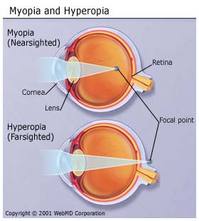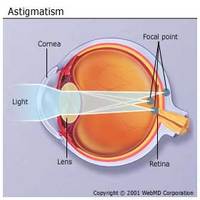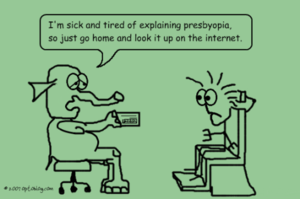Why do I Need Glasses?
There are four common conditions that cause people to need glasses to see clearly. They are myopia, hyperopia, astigmatism, and presbyopia. These conditions are all types of refractive error and they are not pathological. Myopia is another name for “nearsightedness.” Nearsighted people have difficulty seeing far away, for example seeing highway signs when driving. They generally have no problems seeing up close for things like reading or sewing.

Eyes with myopia or hyperopia are too long or too short for light to be focused directly on the retina.
WebMD
Symptoms of myopia include eyestrain or squinting when trying to focus on something far away. This occurs because they eye is longer than usual which causes images to be focused in front of the retina instead of directly on it. Myopia usually begins in childhood and progresses until the eye stops growing. In some cases it continues to worsen well into adulthood. Myopia tends to run in families and it is treated with glasses, contact lenses, or laser surgery such as LASIK. If a prescription has a “minus” in front of it (-1.50) it means the person is nearsighted.
Hyperopia is another name for farsightedness. People who are farsighted have more trouble seeing things close-up than far away. Symptoms of farsightedness include headaches or eyestrain when doing close tasks like reading or sewing. Hyperopia occurs when the eye is shorter than normal, causing light to be focused behind the retina instead of directly on it. Most children are born farsighted but some outgrow it as they eye naturally lengthens during development. Glasses, contact lenses, and eye surgery are all treatments for farsightedness. If a prescription has a “plus” in front of it (+1.50) this indicates that is for farsightedness.

Astigmatism causes light to be focused in two places on the retina instead of one.
WebMD
Astigmatism occurs when the cornea, the front part of the eye, or lens, inside the eye, is irregularly shaped. Astigmatism usually accompanies nearsightedness or farsightedness. Small amounts of astigmatism may not be noticed or only cause a slight blurring of the vision. Higher amounts can cause eyestrain or blur at distance and near. An eye with astigmatism is more oblong or football shaped than a normal, spherical eye. This causes light to be focused at two points on the retina instead of one. Astigmatism is inherited and can occur at any age. If an eyeglass or contact lens prescription has three parts (ex: -4.50 -1.50 x 180) it means that there is astigmatism. The first part of the prescription (-4.50) is the spherical part and this indicates the amount of nearsightedness or farsightedness. The second part (-1.50) is called the cylindrical component and it indicates the amount of astigmatism. The third part of the prescription (x 180) is the cylinder axis and it describes the orientation, in degrees, of the astigmatism correction. Most cases of astigmatism are considered “regular” and can be corrected with eyeglasses, contact lenses, or eye surgery. “Irregular” astigmatism is more difficult to correct and may require special contact lenses or eye surgery. The last type of refractive error is called presbyopia. It occurs in people over the age of 40 and causes difficulty seeing things up close. Everyone develops presbyopia eventually even if they have never had any vision problems before. Even people who are nearsighted will notice that it becomes more difficult to focus on things up close while wearing their normal distance correction. They may need to remove their distance glasses in order to see clearly.

Presbyopia occurs when the natural lens inside the eye loses elasticity due to the normal aging process. The lens needs to change shape in order to focus up close. As the lens hardens over time it can no longer change shape. This is normally a gradual process that begins around age 40.
At early stages of presbyopia a person may notice they need to hold things further away to focus or use more light to read. Bifocals and progressive lenses are types of eyeglasses that are used to correct presbyopia. Bifocal means that the lens has two focal lengths, one for seeing far and one for seeing near. A bifocal lens has a line in it to separate the two prescriptions. A progressive lens is a bifocal without a line that offers a more gradual transition between the two prescriptions. Single vision reading glasses can also be used to correct vision for near work but must be removed for viewing far away distances.
Contacts can also be used to correct presbyopia. Multifocal or monovision contacts can provide vision at most distances but may not be as clear as glasses. Multifocal contacts give each eye a distance and a reading prescription, monovision works by using one eye for distance and the other eye for near. A third option is to use contacts to correct the distance vision and wear reading glasses over them to correct close vision.

Optoblog
Most people have some type of refractive error and it is important to visit an optometrist for a comprehensive eye exam each year to maintain clear vision at all distances and to check for eye health problems.
Dr. Jamie Barnes is an associate doctor at Bennett Optometry, with two locations in Ann Arbor. Contact her at bennettoptometry@gmail.com. Please visit our webite http://www.bennettoptometry.com.

